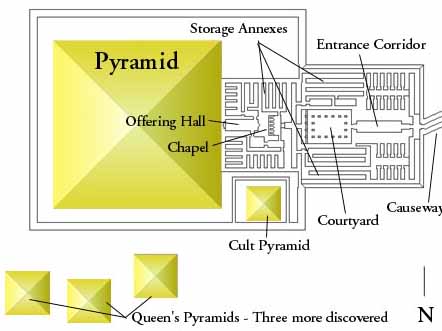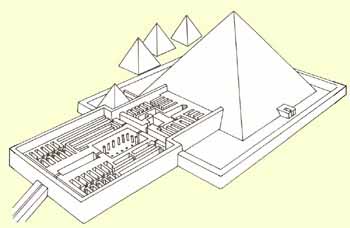
Pepi I was the second ruler of ancient Egypt's 6th Dynasty, and his pyramid at South Saqqara, though no more then a twelve meter high ruin today, has actually had a significant effect on Egyptology. From the fragments of Khamuaset's restoration text, we do know that the pyramid was in good shape during the 19th Dynasty, with few improvements. This pyramid was first investigated by Perring in the 1830s, but in 1881, Maspero entered the subterranean section of the pyramid and there for the first time discovered pyramid texts. This pyramid continues to be scrutinized by the French archaeological mission in Saqqara, originally lead by Lauer and Sainte Fare Garnot, but since 1963 by Leclant and Labrousse. Among other finds, they have discovered the small pyramid complexes of Pepi's consorts.
There was apparently a valley temple and causeway, though we have no information on these structures.
The mortuary complex is almost a duplicate of that in Teti's complex. It is fairly symmetrical and as usual, consisted of inner and outer sections. The causeway leads in from the northeast, leading into first an entrance corridor which in turn leads to a columned courtyard. A transverse corridor splits the outer and inner sections. An doorway in the middle of the back wall of this corridor leads into a five niche chapel, which then leads to the offering hall with its false door on the wall adjacent to the pyramid.

While stone thieves seriously damaged the complex, important discovered were nevertheless made. These included limestone statues of kneeling enemies of Egypt with their hands tied behind their backs. They once stood in the open courtyard, and may also adorned the entrance corridor. These types of statues have been found in several pyramids and perhaps had the function of frightening away anyone who might wish to damage the structure. They symbolized conquered evil.
On the foundation of the pyramid was also found a small cult pyramid.
Pepi I's pyramid has a core of six steps and was constructed in much the same way as Djedkare's pyramid, which used small blocks of limestone bound with a clay mortar. Interestingly, blocks from Teti's mother, queen Sesheshet, were discovered within the core of this pyramid. This was Pepi's grandmother, and may have been removed from a destroyed building. The pyramid was, as usual, cased with fine white limestone, though it remains intact only at the lowest levels.
The pyramid's entrance is in its courtyard pavement next to its north face. There was probably a chapel here, but nothing of it remains today. The subterranean levels are similar to earlier pyramids of the 5th and 6th Dynasties, beginning with a descending limestone corridor that that leads to a vestibule. After the vestibule, the next corridor is level but is reinforced at three places with pink granite. Located about in the middle of this second corridor is the barrier made of three portcullis blocks also of pink granite. This corridor leads to an antechamber on the pyramid's vertical axis. West of the antechamber is the burial chamber, and to its east is a serdab with three niches.

The gabled ceilings of the antechamber and burial chamber consists of three layers of blocks, each layer having sixteen blocks. All together, these ceilings weighed some five thousand tons. The ceiling is astronomical, but with white stars on a black background.
Some burial equipment was found within the pyramid. fragments of a sarcophagus that stood on the west wall of the burial chamber suggest that it was probably a substitute, the original having broken in transportation or perhaps developed flaws. A fragment of a mummy was found that could have been that of Pepi I, but is uncertain, along with some fine linen wrappings. Fourteen shards of yellow alabaster canopic vessels were discovered, together with a small flint knife, a piece of pleated linen and a left sandal of reddish wood, possibly made of sycamore.
Pyramid text not only cover the walls of the antechamber and burial chamber, but also the corridors. Some of these texts remain in place, while others parts are in fragments (about three thousand fragments). In piecing this all together, the French team has discovered that about two thirds of the inscriptions were altered by reducing the size of the glyphs.
Near the pyramid, archaeologists expected to find several queen's pyramids, but instead discovered six. They include the pyramid of Nebuunet and Inenek-Inti, who may also have been wives of Pepi I. Recently, another of these pyramids has been identified as that of Ankhnesmerire II, though in this report she is referred to as Ankhes-en Pepi.




0 comments:
Post a Comment